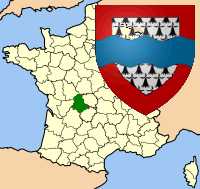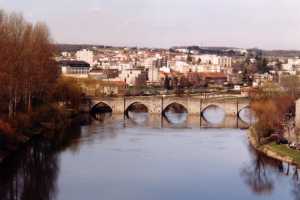Haute-Vienne, Limousin
 I’ve lived in the Haute-Vienne since 1993, and what attracted me to it originally was the sense of an unspoiled, peaceful part of France with enough in the way of hills and valleys to be interesting, and enough lakes to qualify as “The French Lake District”.
I’ve lived in the Haute-Vienne since 1993, and what attracted me to it originally was the sense of an unspoiled, peaceful part of France with enough in the way of hills and valleys to be interesting, and enough lakes to qualify as “The French Lake District”.
There are over 3000 lakes of more than 5 hectares in the Limousin, and 11,000 km of 1 st category fishing rivers.
From medieval times carp have been kept in artificial lakes or ‘etangs’, so it’s easy to see why this part of France is a fishermans paradise.
Some of these lakes have now often been given beaches of golden sand, where children can swim in comparative safety from the first of June under the watchful eye of a professional lifeguard. No need to worry about dangerous currents dragging people out to sea!
Lac de Vassiviere, east of Limoges, is like an inland sea, thousands of hectares of freshwater where you can sail, sailboard, or water ski amidst glorious scenery.

Haute-Vienne Lake
Why the Haute-Vienne?
I love the balance of tracts of beautiful landscape with little farming hamlets hidden away from the roar and bustle of the 20 th century as it then was, shortly after I moved here I remember actually seeing an old couple ploughing a field with oxen….hard to believe, but true! (I wondered if they had been put up to it by the French Tourist Board……)
Often people have commented how the landscape reminds them of parts of the UK.
I’ve heard it compared to Derbyshire, North Devon, Somerset and other counties, but a version unspoiled by the passage of time; a sort of ideal of England as it might have been in our parents or our grandparents childhood .
In the Parc Naturel Perigord-Limousin, the forests of oak and chestnut are still worked in the same way they were in medieval times. This is the land of the foresters, “la pays des Feuillardiers”, where the oak for the barrels used for ageing Cognac are grown, and where they still make the hoops of chestnut for the barrels. Medieval Chateaux fly pennants
If you are out walking on one of the thousands of kilometers of ramblers trails, and you come across something looking like an enormous version of Dougal, the shaggy dog from “Magic Roundabout”, you have met one of the rare Feuillardiers huts, made of chestnut branches and covered in long shavings of chestnut.
These were used as base camp during the summer months when the men were working out away from home in the forest, and are cool and waterproof in the summer heat.
Modern Haute-Vienne
Then I discovered, amidst the sleepy old fashioned country traditions, the other side of the Haute-Vienne. I started finding small high tech companies in ultra-modern buildings, hidden away in the countryside, and then I read that Limoges was being developed as one of three cyber-centers, together with Paris and Lyons.
The most westerly of the three departments of the Limousin region, Haute-Vienne, department 87 is also the most densely populated, and has the Regional capital Limoges as its administrative center.

Limoges, Limousin
Limoges, Haute-Vienne
Limoges, a city already ancient when the Romans arrived, is well known for its porcelain, amongst the best in the world, an industry which developed after kaolin was found at St Yrieix near the Dordogne border, in the south of the department.
It developed the art of enamel in parallel with this, and it’s possible to visit 2 enamel artists workshops with a guide by ringing M.Grafeuille on 05 55 32 32 51, or M.Moussant on 05 55 32 58 56.
Gold in the Limousin
What is less well known about the Limousin is the gold connection.
The geology of the area south of Limoges is granitic mica-schist, and this is well known as being likely to contain gold in commercially interesting quantities. The last goldmine in France was operating till a couple of years ago at Ladinac le Long, on the road to St Yrieix, and a gold museum has recently been opened there.
There is an annual international gold panning convention at Limoges, and there are people, who keep quiet about there exact movements, who do pan for gold in certain streams
Gold and Richard the Lionheart
The whole region of the Pays de Feuillardiers is riddled with stories of the elusive yellow metal, and it was the fatal lure of gold which caused the death of Richard Coeur de Lion 800 years ago, in 1199.
Richard had apparently heard of a fabulous solid gold table and statuary, recently tilled up by a local farmer and then seized by the Viscomte of Limoges and supposedly held in the ancient chateau of Chalus.
There was a small military garrison holding the fort in the absence of the Vicimte, and Richard probably thought it would be an easy operation to take the obscure chateau and seize the treasure, but he had reckoned without the marksmanship of a French crossbowman, who put a bolt into Richard’s shoulder from the top of the 60 metre high round tower.
An unlucky shot for both Richard, who died of blood poisoning a week later, but also for the marksman who was boiled in oil by his own side!
In medieval life, as in chess, you do not take the King!
